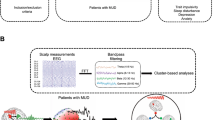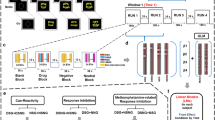Abstract
Bupropion is an antidepressant with stimulant properties, which inhibits the reuptake of dopamine (DA) and norepinepherine, and is purported to enhance DA neurotransmission. Bupropion is considered an appealing candidate medication for the treatment of methamphetamine dependence. The current laboratory study was set forth to assess the impact of bupropion treatment on the subjective effects produced by methamphetamine in the laboratory. We also assessed the effects of bupropion treatment on craving elicited by exposure to videotaped methamphetamine cues. A total of 26 participants were enrolled and 20 completed the entire study (n=10 placebo and n=10 bupropion, parallel groups design). Bupropion treatment was associated with reduced ratings of ‘any drug effect’ (p<0.02), and ‘high’ (p<0.02) following methamphetamine administration. There was also a significant bupropion-by-cue exposure interaction on General Craving Scale total score (p<0.002), and on the Behavioral Intention subscale (p<0.001). Overall, the data reveal that bupropion reduced acute methamphetamine-induced subjective effects and reduced cue-induced craving. Importantly, these data provide a rationale for the evaluation of bupropion in the treatment of methamphetamine dependence.
Similar content being viewed by others
Log in or create a free account to read this content
Gain free access to this article, as well as selected content from this journal and more on nature.com
or
References
Bergman J, Madras BK, Johnson SE, Spealman RD (1989). Effects of cocaine and related drugs in nonhuman primates. III. Self-administration by squirrel monkeys. J Pharmacol Exp Ther 251: 150–155.
Brody AL, Mandelkern MA, Lee G, Smith E, Sadeghi M, Saxena S et al (2004). Attenuation of cue-induced cigarette craving and anterior cingulate cortex activation in bupropion-treated smokers: a preliminary study. Psychiatry Res: Neuroimaging 130: 269–281.
de Lima MS, de Oliveira Soares BG, Reisser AA, Farrell M (2002). Pharmacological treatment of cocaine dependence: a systematic review. Addiction 97: 931–949.
Dong J, Blier P (2001). Modification of norepinephrine and serotonin, but not dopamine, neuron firing by sustained bupropion treatment. Psychopharmacology (Berl) 155: 52–57.
Dworkin SI, Lambert P, Sizemore GM, Carroll FI, Kuhar MJ (1998). RTI-113 administration reduces cocaine self-administration at high occupancy of dopamine transporter. Synapse 30: 49–55.
Ehrman RN, Robbins SJ, Childress AR, O'Brien CP (1992). Conditioned responses to cocaine-related stimuli in cocaine abuse patients. Psychopharmacology 107: 523–529.
Eshleman AJ, Henningsen RA, Neve KA, Janowsky A (1994). Release of dopamine via the human transporter. Mol Pharmacol 45: 312–316.
Fischman MW, Foltin RW (1991). Utility of subjective-effects measurements in assessing abuse liability of drugs in humans. Br J Addict 86: 1563–1570.
Galloway GP, Newmeyer J, Knapp T, Stalcup SA, Smith D (1994). Imipramine for the treatment of cocaine and methamphetamine dependence. J Addict Dis 13: 201–216.
Galloway GP, Newmeyer J, Knapp T, Stalcup SA, Smith D (1996). A controlled trial of imipramine for the treatment of methamphetamine dependence. J Subst Abuse Treat 13: 493–497.
Garbutt JC, West SL, Carey TS, Lohr KN, Crews FT (1999). Pharmacological treatment of alcohol dependence: a review of the evidence [see comments]. JAMA 281: 1318–1325.
Haertzen CA (1965). Addiction Research Center Inventory (ARCI): development of a general drug estimation scale. J Nerv Ment Dis 141: 300–307.
Haertzen CA (1966). Development of scales based on patterns of drug effects, using the addiction Research Center Inventory (ARCI). Psychol Rep 18: 163–194.
Huber A, Ling W, Shoptaw S, Gulati V, Brethen P, Rawson R (1997). Integrating treatments for methamphetamine abuse: a psychosocial perspective. J Addict Dis 16: 41–50.
Huber A, Shoptaw S, Gulati VRG (2000). Sertraline and contingency management as treatments for methamphetamine dependence. Data presented at the annual meeting of the College on the Problems of Drug Dependence, San Juan, PR. pp 70.
Johanson CE, Barrett JE (1993). The discriminative stimulus effects of cocaine in pigeons. J Pharmacol Exp Ther 267: 1–8.
Kim S, Westphalen R, Callahan B, Hatzidimitriou G, Yuan J, Ricaurte GA (2000). Toward development of an in vitro model of methamphetamine-induced dopamine nerve terminal toxicity. J Pharmacol Exp Ther 293: 625–633.
Lamb RJ, Griffiths RR (1990). Self-administration in baboons and the discriminative stimulus effects in rats of bupropion, nomifensine, diclofensine and imipramine. Psychopharmacology (Berl) 102: 183–190.
Learned-Coughlin SM, Bergstrom M, Savitcheva I, Ascher J, Schmith VD, Langstrom B (2003). In vivo activity of bupropion at the human dopamine transporter as measured by positron emission tomography. Biol Psychiatry 54: 800–805.
Marek GJ, Vosmer G, Seiden LS (1990). Dopamine uptake inhibitors block long-term neurotoxic effects of methamphetamine upon dopaminergic neurons. Brain Res 513: 274–279.
Margolin A, Kosten TR, Avants SK, Wilkins J, Ling W, Beckson M et al (1995). A multicenter trial of bupropion for cocaine dependence in methadone-maintained patients. Drug Alcohol Depend 40: 125–131.
Mattick RP, Kimber J, Breen C, Davoli M (2002). Buprenorphine maintenance versus placebo or methadone maintenance for opioid dependence. Cochrane Database Syst Rev CD002207.
McCann UD, Wong DF, Yokoi F, Villemagne V, Dannals RF, Ricaurte GA (1998). Reduced striatal dopamine transporter density in abstinent methamphetamine and methcathinone users: evidence from positron emission tomography studies with [11C]WIN-35,428. J Neurosci 18: 8417–8422.
Merikle EP (1999). The subjective experience of craving: an exploratory analysis. Subst Use Misuse 34: 1101–1115.
Muley MP, Joshi MA, Manekar MS (1984). Effect of bupropion on dopamine and 5-hydroxytryptamine-mediated behaviour in mice. J Pharm Pharmacol 36: 208–210.
Munzar P, Goldberg SR (2000). Dopaminergic involvement in the discriminative-stimulus effects of methamphetamine in rats. Psychopharmacology (Berl) 148: 209–216.
Newton TF, Kalechstein AD, Duran S, Vansluis N, Ling W (2004). Methamphetamine abstinence syndrome: preliminary findings. Am J Addict 13: 248–255.
Newton TF, Roache JD, De La Garza II R, Fong T, Wallace CL, Li SH et al (2005). Safety of intravenous methamphetamine administration during treatment with bupropion. Psychopharmacology 182: 426–435.
O'Brien CP, Testa T, O'Brien TJ, Greenstein R (1976). Conditioning in human opiate addicts. Pavlov J Biol Sci 11: 195–202.
Overall JE, Gorham DR (1962). The Brief Psychiatric Rating Scale. Psychol Rep 10: 799–812.
Pesola GR, Avasarala J (2002). Bupropion seizure proportion among new-onset generalized seizures and drug related seizures presenting to an emergency department. J Emerg Med 22: 235–239.
Rau KS, Birdsall E, Hanson JE, Johnson-Davis KL, Carroll FI, Wilkins DG et al (2005). Bupropion increases striatal vesicular monoamine transport. Neuropharmacology 49: 820–830.
Rawson R, McCann M, Huber A, Shoptaw S (1999). Contingency management and relapse prevention as stimulant abuse treatment interventions motivating behavior change among illicit-drug abusers: research on contingency management interventions. American Psychological Association, Washington, DC, US. pp 57–74.
Rawson RA, Marinelli-Casey P, Anglin MD, Dickow A, Frazier Y, Gallagher C et al (2004). A multi-site comparison of psychosocial approaches for the treatment of methamphetamine dependence. Addiction 99: 708–717.
Richmond R, Zwar N (2003). Review of bupropion for smoking cessation. Drug Alcohol Rev 22: 203–220.
Robbins SJ, Ehrman RN, Childress AR, O'Brien CP (1997). Relationships among physiological and self-report responses produced by cocaine-related cues. Addict Behav 22: 157–167.
Rothman RB, Baumann MH, Dersch CM, Romero DV, Rice KC, Carroll FI et al (2001). Amphetamine-type central nervous system stimulants release norepinephrine more potently than they release dopamine and serotonin. Synapse 39: 32–41.
Sasaki JE, Tatham TA, Barrett JE (1995). The discriminative stimulus effects of methamphetamine in pigeons. Psychopharmacology (Berl) 120: 303–310.
Sekine Y, Minabe Y, Ouchi Y, Takei N, Iyo M, Nakamura K et al (2003). Association of dopamine transporter loss in the orbitofrontal and dorsolateral prefrontal cortices with methamphetamine-related psychiatric symptoms. Am J Psychiatry 160: 1699–1701.
Shiffman S, Johnston JA, Khayrallah M, Elash CA, Gwaltney CJ, Paty JA et al (2000). The effect of bupropion on nicotine craving and withdrawal. Psychopharmacology (Berl) 148: 33–40.
Shoptaw S, Rawson RA, McCann MJ, Obert JL (1994). The Matrix model of outpatient stimulant abuse treatment: evidence of efficacy. J Addict Dis 13: 129–141.
Sofuoglu M, Kosten TR (2005). Novel approaches to the treatment of cocaine addiction. CNS Drugs 19: 13–25.
Stahl SM, Pradko JF, Haight BR, Modell JG, Rockett CB, Learned-Coughlin S (2004). A review of the neuropharmacology of bupropion, a dual norepinephrine and dopamine reuptake inhibitor. Prim Care Companion J Clin Psychiatry 6: 159–166.
Tiffany ST, Drobes DJ (1991). The development and initial validation of a questionnaire on smoking urges. Br J Addict 86: 1467–1476.
Tiffany ST, Singleton E, Haertzen CA, Henningfield JE (1993). The development of a cocaine craving questionnaire. Drug Alcohol Depend 34: 19–28.
Volkow ND, Chang L, Wang GJ, Fowler JS, Franceschi D, Sedler M et al (2001). Loss of dopamine transporters in methamphetamine abusers recovers with protracted abstinence. J Neurosci 21: 9414–9418.
Whiteman PD, Peck AW, Fowle AS, Smith PR (1983). Failure of bupropion to affect prolactin or growth hormone in man. J Clin Psychiatry 44: 209–210.
Wilson JM, Kalasinsky KS, Levey AI, Bergeron C, Reiber G, Anthony RM et al (1996). Striatal dopamine nerve terminal markers in human, chronic methamphetamine users. Nat Med 2: 699–703.
Acknowledgements
This project was supported by contracts from NIDA (DA-08804, DA 014593 and RR-00865).
Author information
Authors and Affiliations
Corresponding author
Rights and permissions
About this article
Cite this article
Newton, T., Roache, J., De La Garza, R. et al. Bupropion Reduces Methamphetamine-Induced Subjective Effects and Cue-Induced Craving. Neuropsychopharmacol 31, 1537–1544 (2006). https://doi.org/10.1038/sj.npp.1300979
Received:
Revised:
Accepted:
Published:
Issue date:
DOI: https://doi.org/10.1038/sj.npp.1300979
Keywords
This article is cited by
-
Effects of methamphetamine-induced neurotoxicity on striatal long-term potentiation
Psychopharmacology (2022)
-
No evidence of subgroups found in amphetamine consumers in Iran
neuropsychiatrie (2018)
-
Effects of Environmental Manipulations and Treatment with Bupropion and Risperidone on Choice between Methamphetamine and Food in Rhesus Monkeys
Neuropsychopharmacology (2015)
-
The Effects of Naltrexone on Subjective Response to Methamphetamine in a Clinical Sample: a Double-Blind, Placebo-Controlled Laboratory Study
Neuropsychopharmacology (2015)
-
Bupropion, methylphenidate, and 3,4-methylenedioxypyrovalerone antagonize methamphetamine-induced efflux of dopamine according to their potencies as dopamine uptake inhibitors: implications for the treatment of methamphetamine dependence
BMC Research Notes (2013)



